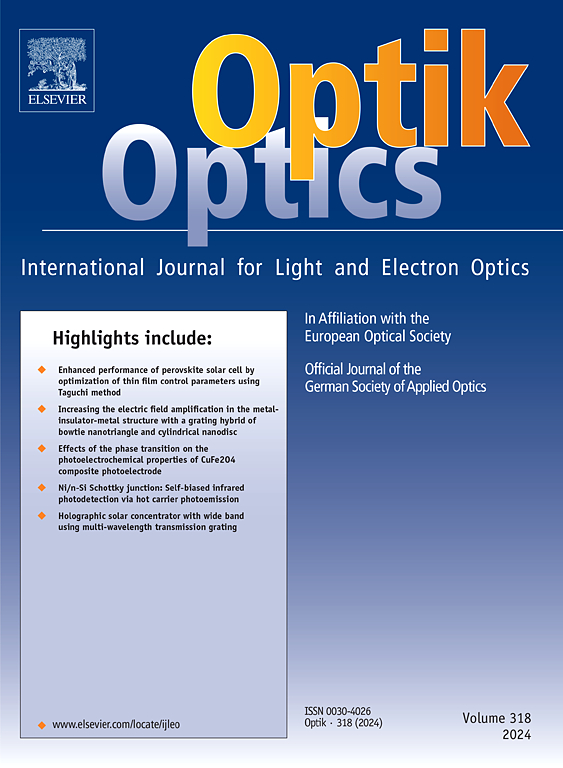A triband graphene-based linear array THz antenna for 6G IoT applications using Spotted Hyena Optimizer
IF 3.1
3区 物理与天体物理
Q2 Engineering
引用次数: 0
Abstract
This study introduces a novel tri-band terahertz (THz) antenna array designed with graphene on a flexible, low-profile polyimide base, integrated with a SiO₂ layer. The antenna element comprises a hexagonal patch integrated with a cross slot and a cross loop resonator, enabling three distinct resonances at 0.252 THz (sub-THz), 0.493 THz (transition range), and 0.696 THz (THz regime). These bands are realised through geometrical evolution and strong inter-resonator coupling. The structure is optimised using the Spotted Hyena Optimizer (SHO) to achieve fractional bandwidths of 10.7 %, 8.3 %, and 8.05 %, respectively. The design is further extended into a two-element differential-fed array with an element spacing of 0.034λ at 0.252 THz, which ensures excellent isolation above 50 dB across all frequency bands. The proposed array achieves gains of 7.22 dBi, 11.106 dBi, and 11.06 dBi at the three operating bands with corresponding efficiencies of 85 %, 87 %, and 86 %, confirming its high-performance radiation capability. The estimated Multiple Input Multiple Output (MIMO) performance shows an Envelope Correlation Coefficient (ECC) below 0.01, apparent Diversity Gain (DG) close to 10 dB, and a low Total Active Reflection Coefficient (TARC), confirming high diversity performance. The antenna’s compact geometry, superior electromagnetic isolation, and consistent far-field patterns position it as a suitable option for 6 G IoT systems and integrated THz networks.
一种基于石墨烯的三波段线性阵列太赫兹天线,用于6G物联网应用,使用斑点鬣狗优化器
本研究介绍了一种新型的三波段太赫兹(THz)天线阵列,该天线阵列采用石墨烯设计在柔性、低姿态的聚酰亚胺基板上,并集成了SiO₂层。天线元件包括一个集成了交叉槽和交叉环谐振器的六角形贴片,在0.252 太赫兹(次太赫兹)、0.493 太赫兹(过渡范围)和0.696 太赫兹(太赫兹区)实现三种不同的谐振。这些波段是通过几何演化和强腔间耦合实现的。利用斑点鬣狗优化器(spot Hyena Optimizer, SHO)对结构进行了优化,分别实现了10.7 %、8.3 %和8.05 %的分数带宽。该设计进一步扩展为双单元差分馈电阵列,元件间距为0.034λ,在0.252 太赫兹处,可确保在所有频段内50 dB以上的出色隔离。该阵列在三个工作频段的增益分别为7.22 dBi、11.106 dBi和11.06 dBi,效率分别为85 %、87 %和86 %,具有良好的辐射性能。估计的多输入多输出(MIMO)性能显示包络相关系数(ECC)低于0.01,表观分集增益(DG)接近10 dB,总主动反射系数(TARC)较低,证实了高的分集性能。该天线紧凑的几何结构、卓越的电磁隔离和一致的远场模式使其成为6 G物联网系统和集成太赫兹网络的合适选择。
本文章由计算机程序翻译,如有差异,请以英文原文为准。
求助全文
约1分钟内获得全文
求助全文
来源期刊

Optik
物理-光学
CiteScore
6.90
自引率
12.90%
发文量
1471
审稿时长
46 days
期刊介绍:
Optik publishes articles on all subjects related to light and electron optics and offers a survey on the state of research and technical development within the following fields:
Optics:
-Optics design, geometrical and beam optics, wave optics-
Optical and micro-optical components, diffractive optics, devices and systems-
Photoelectric and optoelectronic devices-
Optical properties of materials, nonlinear optics, wave propagation and transmission in homogeneous and inhomogeneous materials-
Information optics, image formation and processing, holographic techniques, microscopes and spectrometer techniques, and image analysis-
Optical testing and measuring techniques-
Optical communication and computing-
Physiological optics-
As well as other related topics.
 求助内容:
求助内容: 应助结果提醒方式:
应助结果提醒方式:


